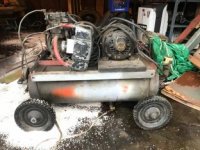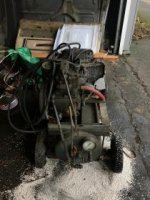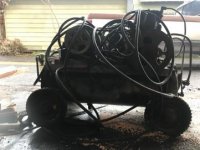The motor is likely a repulsion-induction motor, and could date from the 30's into the 50's. The images of the compressor are kind of small and hard to see much detail, so can't tell anything else.
As for inflating the tires on Duck Boats on the beaches, I kind of doubt that. The Ducks usually had an on-board air compressor driven off the engine. First edition Ducks had a hose and the crew had to get out of the vehicle to adjust tire pressures based on what they were going to drive on. Second edition of the Ducks had an integrated tire pressure control system which had connections to each wheel via a swivel union or similar connection. For running on sand, the tires were deflated to a very low pressure to cause them to spread wide and lower the ground pressure. For hard surfaced roads, the tires were inflated to a higher pressure. There was a chart fastened to the dashboard or near to it of tire pressures. Later ducks had a tire pressure gauge and means of sending air or bleeding it off of each tire while the duck was in motion, or at least without the crew having to climb out.
It would seem a bit odd for the compressor unit in this thread to have been intended for use when duck boats came off the beach. The compressor looks to be of small capacity, and being electric, where would it be plugged in for power in that sort of application ? Aside from all else, anything the military ordered was usually way overbuilt, and a motor for use outdoors near beaches would have been totally enclosed. Chances are this is simply an old compressor unit built for civilian use. Military stuff built during the WWII era along with the duck vehicles would have had a specification and instruction nameplate riveted to it. It may have started out as a military compressor unit for a maintenance shop or similar, not specifically for ducks but after nearly 74 years since the end of WWII, that compressor has been through a few changes. The Duck type amphibious vehicles were quite interesting in their own right. A naval architect who had spent his career previous to WWII designing pleasure craft was handed the assignment of converting a military truck chassis into an amphibious vehicle. The time frame to come up with a design and working prototype was ridiculously short, and the initial design worked. Production of the Duck vehicles began shortly afterwards. The Duck used a 6 cylinder gasoline engine and truck driveline with some modifications in the form of a transfer case which could connect the engine to the prop shafts. The engine itself was fitted with a fairly high capacity centrifugal pump as a bilge pump, since it was a foregone conclusion that the Ducks would wind up taking water aboard in any kind of sea. The ducks were fitted with a "sea breaker" that was raised on the foredeck to divert waves coming over the bow, but it was inevitable that the ducks would be taking on water, and more than a normal capacity bilge pump would be needed. The issue of being able to drive the ducks, particularly when loaded with cargo, on sandy beaches was addressed by the on-board air compressor and tire pressure control piping.
The US Military during WWII used a variety of electric currents to run field equipment. Some was AC power, such as your compressor, and some stuff was built to run on 24 volts DC, to be run by plugging into military vehicle charging systems. The motor on your compressor was likely made by "Master", a firm in Dayton, Ohion, judging by the design of the end shield/air vents in your photo. As I wrote, this style of motor was built into the 50's or maybe as late as the early 60's.
The biggest concern with any old compressor such as this one is the actual condition of the air tank (also known as a "receiver"). Compressed air contains moisture and that moisture condenses and lays in the bottom of air tanks on compressors. There should be a drain petcock to blow down the tank and get rid of the condensate. However, corrosion is at work from within on most air tanks. An old air tank should be regarded as a potential bomb. When a tank containing compressed air ruptures, it is a violent expansion of the air and the tank typically rips apart, often launching shrapnel aside from releasing a great amount of energy. Air, being compressible, expands back to atmospheric pressure and from the small volume of the tank to the much larger volume at atmospheric pressure. Ideally, if a person wanted to be safe in using an unknown/old air tank on a used compressor, they should do the following:
-inspect the tank thoroughly for signs of damage (denting, bulging, excessive corrosion on the exterior of the tank). Any of this is cause to take the tank out of service
-inspect the tank for signs of modifications or repairs. A tank is a pressure vessel, and is ideally (but not always) built to the ASME unfired pressure vessel code. Tanks built to this code will carry a nameplate tack welded to the tank with a "cloverleaf" symbol with the letter "U" in the middle for Unfired Pressure Vessel.
There will be the tank builder's shop name & location, date of mfr, maximum allowable working pressure and a National Board Number. Plenty of non-code tanks are out there in states where this is not a requirement, or brought in from other states and used "under the radar" if a code stamped pressure vessel law is in force.
Any modifications to a pressure vessel must be made by a shop doing the work in accordance with the ASME Pressure Vessel Code, and this is no small feat to accomplish. It does not pay to do this on air compressor tanks. If you see stuff welded into the tank or onto it that looks scabby, stuff like pipe connections welded into the tank with the weld slobbered on, this is a dead giveaway that the tank has been modified and may not be sound or properly done. If this is apparent, the tank should be cut up to prevent re-use.
-If the tank passes visual inspection, the next step is to have it thickness gauged ultrasonically. This can be done by a pressure vessel shop or fab shop having a UT tester. The normal thing is to then take the minimum as-gauged thicknesses of the different parts of the tank and "run the numbers" (calculations) to determine what working pressure they will withstand based on a minimum factor of safety of 5.0. Once this is done, a Maximum Allowable Working Pressure (MAWP) is established and this has to be compared to what the safety or "pop" valve on the tank is set to open at.
-Once the MAWP is calculated based on as-gauged minimum thicknesses, the final step is a hydrostatic pressure test. This, as the name implies, is a pressure test done using water. Water, being incompressible, will not rupture the tank violently as happens with a compressible gas like air. The tank is filled with water and any air bled off. All connections to things like pressure switch, gauge, safety valve, etc are plugged off. The water is pumped up to 1.25 x MAWP and the tank is inspected for any signs of failure such as leaks that develop (pissers), or deformation such as bulging. If the tank passes hydro, it is then considered fit for service at the calculated MAWP.
We regard used/old/unknown air tanks as bombs. As board member John Ruth has aptly stated on other threads on this board, "boiler codes are written in blood". A lot of sad truth to that. People tend to dismiss air tanks as benign and do not usually think of them in the same class as a high pressure boiler. There have been some horrific incidents where air tanks "let go" with no warning. At the powerplant I retired from, one yearly event was the visit from the insurance company's risk assessment team. This team was made up of older and well experienced engineers with a lot of practical experience. We had some huge air receivers (9600 gallons of stored air capacity at 140 psig) and many smaller receivers in the plant and the risk assessment team would pounce on that and want records of inspections, UT's hydro tests and any repairs or modifications (we would bring in a National Board registered boiler shop with an ASME "R" stamp). The risk assessment engineers would always have some new horror story of how another air receiver in some industrial application let go and the personal injury and damage it caused.
Your air tank is relatively small, but still not to be taken lightly. It is an unknown, and coming from an estate, as the saying goes, "dead men tell no tales". Who knows how well it was maintained ? Was it blown down at least once daily when it was pressurized and in use ? Highly unlikely. If it s a non-code tank, there will be no data plate on it, so you have no idea of what the designed MAWP was. Taking it on blind faith that the tank is good for whatever the pressure switch and safety valve are set for is not good enough nor safe. Some investigation and a hydro test would be the thing I'd be doing before I put that tank into use. I'd also put a new ASME code safety valve (pop valve, not expensive for this size of tank) on the tank to be sure it opened at the proper pressure and reseated and at least check the pressure gauge against a gauge of known accuracy.
A friend of mine told me a tale of a yard sale compressor that happened at his neighbor's. The neighbor bought a small compressor with an air tank at a yard sale.
The neighbor took the compressor into his back yard, which abuts my buddy's auto repair shop property. The neighbor plugged the compressor in and it started right up. There was a pinhole leak in the air tank, but the neighbor figured it was not hurting anything to use the compressor with that leaking tank. He got to using the compressor for something or other, and the next thing my buddy knew was there was a hell of a racket from the neighbor's yard. The air tank had ruptured. The result was it launched the compressor straight up into the air. The neighbor said it looked like it reached the height of the eaves of his one story house, about 12 feet off the ground, then came crashing down. No harm to the neighbor, just scared him good.
Sorry to throw a bucket of ice water on ideas you may have for that compressor. I am an old-time mechanical engineer who has done a good bit of engineering work on locomotive boilers, and some on other pressure vessels, aside from plenty of experience around compressed air. It is nothing to be taken lightly, and your old compressor tank is something that really needs to be properly inspected and tested if you intend to use it. The other recourse- assuming the compressor and motor are worth re-using- is to mount them on a new air tank. I am sure other board members will chime in about the dangers in old air tanks.







